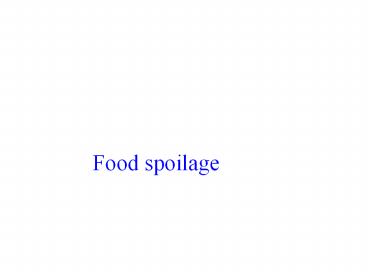Food spoilage - PowerPoint PPT Presentation
1 / 32
Title:
Food spoilage
Description:
Food spoilage Conditions for Spoilage Water pH Physical structure Oxygen temperature Microorganism Growth in Foods Intrinsic Factors composition pH presence and ... – PowerPoint PPT presentation
Number of Views:2326
Avg rating:3.0/5.0
Title: Food spoilage
1
Food spoilage
2
Conditions for Spoilage
- Water
- pH
- Physical structure
- Oxygen
- temperature
3
Microorganism Growth in Foods
4
Intrinsic Factors
- composition
- pH
- presence and availability of water
- oxidation-reduction potential
- altered by cooking
- physical structure
- presence of antimicrobial substances
5
Composition and pH
- putrefaction
- proteolysis and anaerobic breakdown of proteins,
yielding foul-smelling amine compounds - pH impacts make up of microbial community and
therefore types of chemical reactions that occur
when microbes grow in food
6
Water availability
- in general, lower water activity inhibits
microbial growth - water activity lowered by
- drying
- addition of salt or sugar
- osmophilic microorganisms
- prefer high osmotic pressure
- xerophilic microorganisms
- prefer low water activity
7
Physical structure
- grinding and mixing increase surface area and
distribute microbes - promotes microbial growth
- outer skin of vegetables and fruits slows
microbial growth
8
Antimicrobial substances
- coumarins fruits and vegetables
- lysozyme cows milk and eggs
- aldehydic and phenolic compounds herbs and
spices - allicin garlic
- polyphenols green and black teas
9
Extrinsic Factors
- temperature
- lower temperatures retard microbial growth
- relative humidity
- higher levels promote microbial growth
- atmosphere
- oxygen promotes growth
- modified atmosphere packaging (MAP)
- use of shrink wrap and vacuum technologies to
package food in controlled atmospheres
10
Microbial Growth and Food Spoilage
- food spoilage
- results from growth of microbes in food
- alters food visibly and in other ways, rendering
it unsuitable for consumption - involves predictable succession of microbes
- different foods undergo different types of
spoilage processes - toxins are sometimes produced
- algal toxins may contaminate shellfish and finfish
11
(No Transcript)
12
Food Spoilage
- Approximately 1/3rd of all food manufactured in
world is lost to spoilage - Microbial content of foods (microbial load)
qualitative (which microbe) and quantitative (how
many microbes) - Shelf life
- Non-perishable foods (pasta)
- Semiperishable foods (bread)
- Perishable foods (eggs)
13
General Principles
- Minimize contamination by
- Good management processes
- Acceptable sanitary practices
- Rapid movement of food through processing plant
- Well-tested preservation procedures
14
Spoilage
- Meat
- Cutting board contamination
- Conveyor belts
- Temperature
- Failure to distribute quickly
- Fecal bacteria from intestines
- Fish
- Polluted waters
- Transportation boxes
15
Spoilage
- Poultry and Eggs
- Human contact
- Penetration by bacteria
- Milk and Dairy Products
- Lactobacillus and Streptococcus species that
survive pasturization (sour milk) - Breads
- Spores and fungi that survive baking
- Grains
- Fungi produce toxins
16
Food-Borne Diseases
- two primary types
- food-borne infections
- food intoxications
17
Preventing Foodborne Disease
- Food infections (microbes are transferred to
consumer) - Food poisoning (results from the toxin
consumption)
18
(No Transcript)
19
Food-Borne Intoxications
- ingestion of toxins in foods in which microbes
have grown - include staphylococcal food poisoning, botulism,
Clostridium perfringens food poisoning, and
Bacillus cereus food poisoning
20
Toxins
- ergotism
- toxic condition caused by growth of a fungus in
grains - aflatoxins
- carcinogens produced in fungus-infected grains
and nut products - fumonisins
- carcinogens produced in fungus-infected corn
21
(No Transcript)
22
Controlling Food Spoilage
23
Removal of Microorganisms
- usually achieved by filtration
- commonly used for water, beer, wine, juices, soft
drinks, and other liquids
24
Low Temperature
- refrigeration at 5C retards but does not stop
microbial growth - psychrophiles and psychrotrophs can still cause
spoilage - growth at temperatures below -10C has been
observed
25
High Temperature
- canning
- pasteurization
26
Canning
- food heated in special containers (retorts) to
115 C for 25 to 100 minutes - kills spoilage microbes, but not necessarily all
microbes in food
27
Spoilage of canned goods
- spoilage prior to canning
- underprocessing
- leakage of contaminated water into cans during
cooling process
28
Pasteurization
- kills pathogens and substantially reduces number
of spoilage organisms - different pasteurization procedures heat for
different lengths of time - shorter heating times result in improved flavor
29
Water Availability
30
Chemical-Based Preservation
- GRAS
- chemical agents generally recognized as safe
- pH of food impacts effectiveness of chemical
preservative
31
(No Transcript)
32
Radiation
- ultraviolet (UV) radiation
- used for surfaces of food-handling equipment
- does not penetrate foods
- Gamma radiation
- use of ionizing radiation (gamma radiation) to
extend shelf life or sterilize meat, seafoods,
fruits, and vegetables































